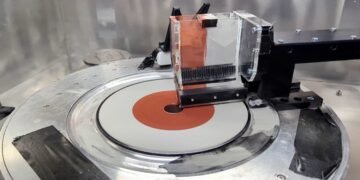Astronomers have been waiting decades for the launch of the James Webb Space Telescope, which promises how to peer farther into space than ever before. But if humans want to actually reach our nearest stellar neighbor, they will need to wait quite a bit longer: a probe sent to Alpha Centauri with a rocket would need roughly 80,000 years to make the trip.
Igor Bargatin, Associate Professor in the Department of Mechanical Engineering and Applied Mechanics, is trying to solve this futuristic problem with ideas taken from one of humanity’s oldest transportation technologies: the sail.
As part of the Breakthrough Starshot Initiative, he and his colleagues are designing the size, shape, and materials for a sail pushed not by wind, but by light.
Using nanoscopically thin materials and an array of powerful lasers, such a sail could carry a microchip-sized probe at a fifth of the speed of light, fast enough to make the trip to Alpha Centauri in roughly 20 years, rather than millennia.
“Reaching another star within our lifetimes is going to require relativistic speed, or something approaching the speed of light,” Bargatin says. “The idea of a light sail has been around for some time, but we’re just now figuring out how to make sure those designs survive the trip.”
Much of the earlier research in the field has presumed that the sun would passively provide all of the energy that light sails would need to get moving. However, Starshot’s plan to get its sails to relativistic speeds requires a much more focused source of energy. Once the sail is in orbit, a massive array of ground-based lasers would train their beams on it, providing light intensity millions of times greater than the suns.
Given that the lasers’ target would be a three-meter-wide structure a thousand times thinner than a sheet of paper, figuring out how to prevent the sail from tearing or melting is a major design challenge.
Bargatin, Deep Jariwala, Assistant Professor in the Department of Electrical and Systems Engineering, and Aaswath Raman, Assistant Professor in the Department of Materials Science and Engineering at the UCLA Samueli School of Engineering, have now published a pair of papers in the journal Nano Letters that outline some of those fundamental specifications.
One paper,[1] led by Bargatin, demonstrates that Starshot’s light sails—proposed to be constructed out of ultrathin sheets of aluminum oxide and molybdenum disulfide—will need to billow like a parachute rather than remain flat, as much of the previous research assumed.
“The intuition here is that a very tight sail, whether it’s on a sailboat or in space, is much more prone to tears,” Bargatin says. “It’s a relatively easy concept to grasp, but we needed to do some very complex math to actually show how these materials would behave at this scale.”
Rather than a flat sheet, Bargatin and his colleagues suggest that a curved structure, roughly as deep as it is wide, would be most able to withstand the strain of the sail’s hyper-acceleration, a pull thousands of times that of Earth’s gravity.
“Laser photons will fill the sail much like air inflates a beach ball,” says Matthew Campbell, a postdoctoral researcher in Bargatin’s group and lead author on the first paper. “And we know that lightweight, pressurized containers should be spherical or cylindrical to avoid tears and cracks. Think of propane tanks or even fuel tanks on rockets.”
The other paper,[2] led by Raman, provides insights into how nanoscale patterning within the sail could most efficiently dissipate the heat that comes along with a laser beam a million times more powerful than the sun.
“If the sails absorb even a tiny fraction of the incident laser light, they’ll heat up to very high temperatures,” Raman explained. “To make sure they don’t just disintegrate, we need to maximize their ability to radiate their heat away, which is the only mode of heat transfer available in space.”
Earlier light-sail research showed that using a photonic crystal design, essentially studding the sail’s “fabric” with regularly spaced holes, would maximize the structure’s thermal radiation. The researchers’ new paper adds another layer of periodicity: swatches of sail fabric lashed together in a grid.
With the spacing of the holes matching the wavelength of light and the spacing of the swatches matching the wavelength of thermal emission, the sail could withstand an even more powerful initial push, reducing the amount of time the lasers would need to stay on their target.
“A few years ago, even thinking or doing theoretical work on this type of concept was considered far-fetched,” Jariwala says. “Now, we not only have a design but the design is grounded in real materials available in our labs. Our plan for the future would be to make such structures at small scales and test them with high-power lasers.”




































